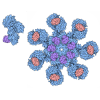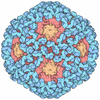+ Open data
Open data
- Basic information
Basic information
| Entry | Database: PDB / ID: 9ncq | ||||||
|---|---|---|---|---|---|---|---|
| Title | Cryo-EM structure of Fas-FADD complex | ||||||
 Components Components |
| ||||||
 Keywords Keywords | IMMUNE SYSTEM / Fas / CD94 / FADD / Caspase / DISC / Apoptosis / Innate Immunity / helical assembly | ||||||
| Function / homology |  Function and homology information Function and homology informationpositive regulation of CD8-positive, alpha-beta cytotoxic T cell extravasation / Fas signaling pathway / cellular response to hyperoxia / negative regulation of activation-induced cell death of T cells / death effector domain binding / tumor necrosis factor receptor activity / tumor necrosis factor receptor superfamily binding / FasL/ CD95L signaling / TRAIL signaling / CD95 death-inducing signaling complex ...positive regulation of CD8-positive, alpha-beta cytotoxic T cell extravasation / Fas signaling pathway / cellular response to hyperoxia / negative regulation of activation-induced cell death of T cells / death effector domain binding / tumor necrosis factor receptor activity / tumor necrosis factor receptor superfamily binding / FasL/ CD95L signaling / TRAIL signaling / CD95 death-inducing signaling complex / activation-induced cell death of T cells / death-inducing signaling complex assembly / ripoptosome / Defective RIPK1-mediated regulated necrosis / TRAIL-activated apoptotic signaling pathway / caspase binding / TRIF-mediated programmed cell death / Regulation by c-FLIP / CASP8 activity is inhibited / Dimerization of procaspase-8 / TLR3-mediated TICAM1-dependent programmed cell death / positive regulation of adaptive immune response / Caspase activation via Death Receptors in the presence of ligand / positive regulation of macrophage differentiation / necroptotic signaling pathway / NF-kB activation through FADD/RIP-1 pathway mediated by caspase-8 and -10 / death-inducing signaling complex / receptor serine/threonine kinase binding / negative regulation of necroptotic process / positive regulation of type I interferon-mediated signaling pathway / tumor necrosis factor receptor binding / positive regulation of innate immune response / death receptor binding / positive regulation of extrinsic apoptotic signaling pathway / TP53 Regulates Transcription of Death Receptors and Ligands / TNFR1-induced proapoptotic signaling / motor neuron apoptotic process / RIPK1-mediated regulated necrosis / regulation of stress-activated MAPK cascade / positive regulation of reactive oxygen species biosynthetic process / positive regulation of activated T cell proliferation / T cell homeostasis / positive regulation of proteolysis / extrinsic apoptotic signaling pathway via death domain receptors / positive regulation of execution phase of apoptosis / lymph node development / spleen development / behavioral response to cocaine / extrinsic apoptotic signaling pathway / signaling adaptor activity / extrinsic apoptotic signaling pathway in absence of ligand / cellular response to amino acid starvation / thymus development / positive regulation of apoptotic signaling pathway / positive regulation of interleukin-8 production / apoptotic signaling pathway / kidney development / Regulation of TNFR1 signaling / cellular response to mechanical stimulus / Regulation of necroptotic cell death / positive regulation of T cell mediated cytotoxicity / kinase binding / cytoplasmic side of plasma membrane / positive regulation of type II interferon production / positive regulation of tumor necrosis factor production / T cell differentiation in thymus / signaling receptor activity / cell body / protease binding / protein-containing complex assembly / regulation of apoptotic process / protein-macromolecule adaptor activity / defense response to virus / calmodulin binding / positive regulation of canonical NF-kappaB signal transduction / immune response / nuclear body / positive regulation of apoptotic process / membrane raft / innate immune response / external side of plasma membrane / apoptotic process / negative regulation of apoptotic process / protein-containing complex binding / cell surface / signal transduction / positive regulation of transcription by RNA polymerase II / extracellular exosome / identical protein binding / plasma membrane / cytoplasm / cytosol Similarity search - Function | ||||||
| Biological species |  Homo sapiens (human) Homo sapiens (human) | ||||||
| Method | ELECTRON MICROSCOPY / single particle reconstruction / cryo EM / Resolution: 3.51 Å | ||||||
 Authors Authors | Fosuah, E. / Lin, Q. / Shen, Z. / Fu, T.M. | ||||||
| Funding support | 1items
| ||||||
 Citation Citation |  Journal: Proc Natl Acad Sci U S A / Year: 2025 Journal: Proc Natl Acad Sci U S A / Year: 2025Title: Assembly and activation of the death-inducing signaling complex. Authors: Elizabeth Fosuah / Zhangfei Shen / Jiale Xie / Chen Wang / Qingpeng Lin / Tian-Min Fu /  Abstract: The death-inducing signaling complex (DISC), comprising Fas, Fas-associated death domain (FADD), and caspase-8, initiates extrinsic apoptosis. Using cryogenic electron microscopy (cryo-EM), we show ...The death-inducing signaling complex (DISC), comprising Fas, Fas-associated death domain (FADD), and caspase-8, initiates extrinsic apoptosis. Using cryogenic electron microscopy (cryo-EM), we show that Fas and FADD death domains (DDs) form an asymmetric 7:5 oligomer, which promotes FADD death effector domain (DED) filament formation. Structural analysis reveals that FADD DED filaments closely resemble caspase-8 tandem DED filaments, suggesting that FADD DED serves as a nucleation scaffold for caspase-8 assembly. These findings provide a mechanistic framework for how DISC assembly initiates apoptosis and amplifies signaling via higher-order oligomerization. | ||||||
| History |
|
- Structure visualization
Structure visualization
| Structure viewer | Molecule:  Molmil Molmil Jmol/JSmol Jmol/JSmol |
|---|
- Downloads & links
Downloads & links
- Download
Download
| PDBx/mmCIF format |  9ncq.cif.gz 9ncq.cif.gz | 197.7 KB | Display |  PDBx/mmCIF format PDBx/mmCIF format |
|---|---|---|---|---|
| PDB format |  pdb9ncq.ent.gz pdb9ncq.ent.gz | 154.6 KB | Display |  PDB format PDB format |
| PDBx/mmJSON format |  9ncq.json.gz 9ncq.json.gz | Tree view |  PDBx/mmJSON format PDBx/mmJSON format | |
| Others |  Other downloads Other downloads |
-Validation report
| Arichive directory |  https://data.pdbj.org/pub/pdb/validation_reports/nc/9ncq https://data.pdbj.org/pub/pdb/validation_reports/nc/9ncq ftp://data.pdbj.org/pub/pdb/validation_reports/nc/9ncq ftp://data.pdbj.org/pub/pdb/validation_reports/nc/9ncq | HTTPS FTP |
|---|
-Related structure data
| Related structure data |  49266MC  9n94C M: map data used to model this data C: citing same article ( |
|---|---|
| Similar structure data | Similarity search - Function & homology  F&H Search F&H Search |
- Links
Links
- Assembly
Assembly
| Deposited unit | 
|
|---|---|
| 1 |
|
- Components
Components
| #1: Protein | Mass: 10857.491 Da / Num. of mol.: 7 Source method: isolated from a genetically manipulated source Source: (gene. exp.)  Homo sapiens (human) / Gene: FAS, APT1, FAS1, TNFRSF6 Homo sapiens (human) / Gene: FAS, APT1, FAS1, TNFRSF6Production host:  References: UniProt: P25445 #2: Protein | Mass: 11554.015 Da / Num. of mol.: 5 Source method: isolated from a genetically manipulated source Source: (gene. exp.)  Homo sapiens (human) / Gene: FADD, MORT1, GIG3 / Production host: Homo sapiens (human) / Gene: FADD, MORT1, GIG3 / Production host:  Has protein modification | N | |
|---|
-Experimental details
-Experiment
| Experiment | Method: ELECTRON MICROSCOPY |
|---|---|
| EM experiment | Aggregation state: PARTICLE / 3D reconstruction method: single particle reconstruction |
- Sample preparation
Sample preparation
| Component | Name: Human Fas-FADD DD complex / Type: COMPLEX / Entity ID: all / Source: RECOMBINANT |
|---|---|
| Source (natural) | Organism:  Homo sapiens (human) Homo sapiens (human) |
| Source (recombinant) | Organism:  |
| Buffer solution | pH: 7.5 |
| Specimen | Embedding applied: NO / Shadowing applied: NO / Staining applied: NO / Vitrification applied: YES |
| Vitrification | Cryogen name: ETHANE |
- Electron microscopy imaging
Electron microscopy imaging
| Experimental equipment |  Model: Titan Krios / Image courtesy: FEI Company |
|---|---|
| Microscopy | Model: TFS KRIOS |
| Electron gun | Electron source:  FIELD EMISSION GUN / Accelerating voltage: 300 kV / Illumination mode: FLOOD BEAM FIELD EMISSION GUN / Accelerating voltage: 300 kV / Illumination mode: FLOOD BEAM |
| Electron lens | Mode: BRIGHT FIELD / Nominal defocus max: 2500 nm / Nominal defocus min: 500 nm |
| Image recording | Electron dose: 50 e/Å2 / Film or detector model: GATAN K3 (6k x 4k) |
- Processing
Processing
| EM software | Name: PHENIX / Category: model refinement | ||||||||||||||||||||||||
|---|---|---|---|---|---|---|---|---|---|---|---|---|---|---|---|---|---|---|---|---|---|---|---|---|---|
| CTF correction | Type: NONE | ||||||||||||||||||||||||
| 3D reconstruction | Resolution: 3.51 Å / Resolution method: FSC 0.143 CUT-OFF / Num. of particles: 643286 / Symmetry type: POINT | ||||||||||||||||||||||||
| Refinement | Highest resolution: 3.51 Å Stereochemistry target values: REAL-SPACE (WEIGHTED MAP SUM AT ATOM CENTERS) | ||||||||||||||||||||||||
| Refine LS restraints |
|
 Movie
Movie Controller
Controller




 PDBj
PDBj











